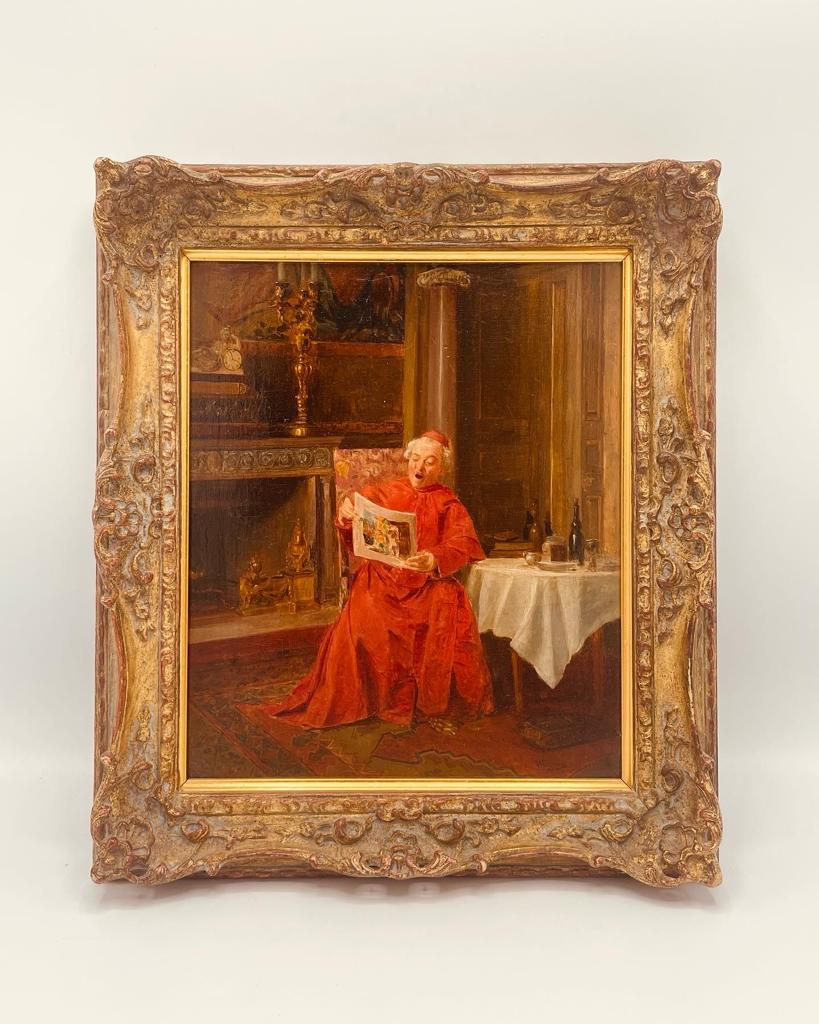Victor Marais- Milton (Puteaux -Parijs 1872-1944 Sèvres)
Une histoire étonnant
Oil on panel
Signed at bottom right VMarais
In a chic interior, a cardinal sits at the table reading a magazine, his mouth falls open with surprise, or does he utter a cry of disapproval? Or does he find the Leaf sleep-inducing and have to yawn. We will not know exactly, but it is obvious that a caricature of a clergyman is depicted here reading a magazine. Color printing was time-consuming around 1900 and therefore only destined for magazines and not newspapers.
The painting was manufactured by Victor Marais Milton.
He is a transitional artist from the nineteenth to the twentieth century who was very successful in Paris in the caricature genre. During this period, genre painting made a comeback. In the genre pieces in which the mockery of the established order was made, Marais Milton, like some of his contemporaries, combined the demand for genre pieces with caricatural mockery. With a sense of detail and realism, Marais subtly depicts the comic adventures of his subject, particularly those of Cardinals.
Victor Marais-Milton was born on 21 July 1872 in Puteaux, just west of Paris on the Seine. At the beginning of his career he lived in Paris, but later moved to Sèvres, where he remained until his death. He studied in the studio of Jonchère, but is also associated with Ernest Meissonnier, a master of genre painting and an inspiration to many artists, while working as a teacher in his own studio at the École des Beaux-Arts. Victor Marais Milton stayed away from the avant-garde and especially stuck to his anecdotal genre painting of clerics that eagerly found traction not only among the Parisian clientele but also in the United States.
The appreciation for this theme reflected in the nineteenth century the renewed interest in the Dutch genre paintings of the seventeenth century. The anti-clericalism that grew throughout the nineteenth century was a source of gratitude to Marais Milton and his colleagues. in printmaking, it was Daumier who notably produced political genre pieces for Illustrated magazines. This popular theme was thus widely carried and understood by every viewer.
Collectors and spectators were amused by the sight of noble figureheads of the church, reduced to banal, even unworthy proportions. The comedy was appealing and the anticlerical message suited the prevailing political mood among the buying public.
After Marais Milton had moved to Sèvres, he had at his disposal a studio with a large window. In his paintings, the effect of this window can often be seen. His subjects are clearly illuminated. Sometimes the window can even be seen in his paintings.
For his ecclesiastical subjects he dressed his models appropriately. The interior reflects its own dwelling. Several of the pieces of furniture regularly featured in his paintings were in his home in Sèvres.
